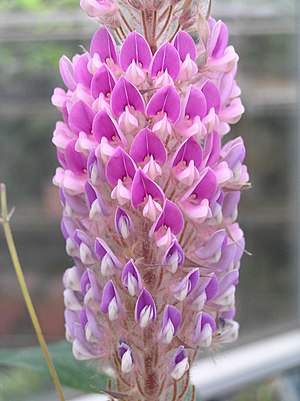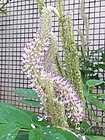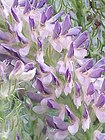Note: This is a project under development. The articles on this wiki are just being initiated and broadly incomplete. You can Help creating new pages.
Difference between revisions of "Uraria crinita"
(Created page with "{{stub}} ==Uses== {{Uses|}}, {{Uses|}}, {{Uses|}}, {{Uses|}}, {{Uses|}}, {{Uses|}}, {{Uses|}}, {{Uses|}}, {{Uses|}}, {{Uses|}}, {{Uses|}}.<ref name="Uses"/> ==Parts Used== {{...") |
|||
| Line 1: | Line 1: | ||
| − | + | [[File:貓尾草 Uraria crinita -香港嘉道理農場 Kadoorie Farm, Hong Kong- (9198167745).jpg|thumb|right|''Uraria crinita'']] | |
| + | '''Uraria crinita''' is an erect perennial plants with stems up to 2 metres tall that become woody at least at the base. The plant is often gathered from the wild and used locally as a medicinal herb. It is also grown as a green manure and is sometimes grown in gardens as an ornamental. | ||
==Uses== | ==Uses== | ||
| − | {{Uses|}}, {{Uses|}}, {{Uses|}}, {{Uses|}}, {{Uses|}}, {{Uses| | + | {{Uses|Dysentery}}, {{Uses|Diarrhoea}}, {{Uses|Enlarged spleen}}, {{Uses|Liver}}, {{Uses|Tumours}}, {{Uses|Fistulae}}.<ref name="Uses"/> |
==Parts Used== | ==Parts Used== | ||
| − | {{Parts Used| | + | {{Parts Used|Whole plant}}. |
==Chemical Composition== | ==Chemical Composition== | ||
| − | <ref name="chemical composition"/> | + | A new isoflavanone, (3S)-5,7-dihydroxy-2′,3′,4′-trimethoxy-6,5′ diprenylisoflavanone (1) and eight known compounds including five flavones (2–6), two triterpenes (7–8) and a steroid (9) were isolated from the whole plant of Uraria crinita (Leguminosae).<ref name="chemical composition"/> |
==Common names== | ==Common names== | ||
| Line 16: | Line 17: | ||
===Dravya=== | ===Dravya=== | ||
===Rasa=== | ===Rasa=== | ||
| − | |||
===Guna=== | ===Guna=== | ||
| Line 29: | Line 29: | ||
==Habit== | ==Habit== | ||
| − | {{Habit|}} | + | {{Habit|Perennial}} |
==Identification== | ==Identification== | ||
| Line 48: | Line 48: | ||
==Mode of Propagation== | ==Mode of Propagation== | ||
| − | {{Propagation|}} | + | {{Propagation|Seeds}} |
==How to plant/cultivate== | ==How to plant/cultivate== | ||
| − | <ref name="How to plant/cultivate"/> | + | Requires a well-drained soil.<ref name="How to plant/cultivate"/> |
==Commonly seen growing in areas== | ==Commonly seen growing in areas== | ||
| − | {{Commonly seen|}}, {{Commonly seen|}}, {{Commonly seen|}}, {{Commonly seen|}}, {{Commonly seen|}}. | + | {{Commonly seen|Dry grassland}}, {{Commonly seen|Open forest}}, {{Commonly seen|Waste places}}, {{Commonly seen|Roadsides}}, {{Commonly seen|Sandy areas}}. |
==Photo Gallery== | ==Photo Gallery== | ||
<gallery class="left" caption="" widths="140px" heights="140px"> | <gallery class="left" caption="" widths="140px" heights="140px"> | ||
| − | + | Uraria crinita.JPG | |
| + | 兔尾草 20190810210656 01.jpg | ||
| + | 兔尾草 20190810210656 04.jpg | ||
| + | 兔尾草 20190810210656 07.jpg | ||
| + | 猫尾草 Uraria crinita.jpg | ||
| + | 貓尾草 Uraria crinita -香港嘉道理農場 Kadoorie Farm, Hong Kong- (9198167745).jpg | ||
</gallery> | </gallery> | ||
| Line 64: | Line 69: | ||
<references> | <references> | ||
| − | <ref name="chemical composition">[ | + | <ref name="chemical composition">[https://www.tandfonline.com/doi/abs/10.1080/14786419.2019.1667352#:~:text=A%20new%20isoflavanone%2C%20(3S)%2D,of%20Uraria%20crinita%20(Leguminosae). Chemical constituents]</ref> |
| − | <ref name="Leaf">[ | + | <ref name="Leaf">[Morphology]</ref> |
| − | <ref name="How to plant/cultivate">[ | + | <ref name="How to plant/cultivate">[http://tropical.theferns.info/viewtropical.php?id=Uraria+crinita Cultivation]</ref> |
<ref name="Uses">Indian Medicinal Plants by C.P.Khare</ref> | <ref name="Uses">Indian Medicinal Plants by C.P.Khare</ref> | ||
</references> | </references> | ||
| Line 74: | Line 79: | ||
==External Links== | ==External Links== | ||
* [ ] | * [ ] | ||
| − | + | ||
| − | |||
[[Category:Herbs]] | [[Category:Herbs]] | ||
Latest revision as of 22:04, 28 August 2020
Uraria crinita is an erect perennial plants with stems up to 2 metres tall that become woody at least at the base. The plant is often gathered from the wild and used locally as a medicinal herb. It is also grown as a green manure and is sometimes grown in gardens as an ornamental.
Contents
- 1 Uses
- 2 Parts Used
- 3 Chemical Composition
- 4 Common names
- 5 Properties
- 6 Habit
- 7 Identification
- 8 List of Ayurvedic medicine in which the herb is used
- 9 Where to get the saplings
- 10 Mode of Propagation
- 11 How to plant/cultivate
- 12 Commonly seen growing in areas
- 13 Photo Gallery
- 14 References
- 15 External Links
Uses
Dysentery, Diarrhoea, Enlarged spleen, Liver, Tumours, Fistulae.[1]
Parts Used
Chemical Composition
A new isoflavanone, (3S)-5,7-dihydroxy-2′,3′,4′-trimethoxy-6,5′ diprenylisoflavanone (1) and eight known compounds including five flavones (2–6), two triterpenes (7–8) and a steroid (9) were isolated from the whole plant of Uraria crinita (Leguminosae).[2]
Common names
| Language | Common name |
|---|---|
| Kannada | |
| Hindi | |
| Malayalam | |
| Tamil | |
| Telugu | |
| Marathi | |
| Gujarathi | |
| Punjabi | |
| Kashmiri | |
| Sanskrit | |
| English |
Properties
Reference: Dravya - Substance, Rasa - Taste, Guna - Qualities, Veerya - Potency, Vipaka - Post-digesion effect, Karma - Pharmacological activity, Prabhava - Therepeutics.
Dravya
Rasa
Guna
Veerya
Vipaka
Karma
Prabhava
Habit
Identification
Leaf
| Kind | Shape | Feature |
|---|---|---|
Flower
| Type | Size | Color and composition | Stamen | More information |
|---|---|---|---|---|
| {{{5}}} |
Fruit
| Type | Size | Mass | Appearance | Seeds | More information |
|---|---|---|---|---|---|
Other features
List of Ayurvedic medicine in which the herb is used
Where to get the saplings
Mode of Propagation
How to plant/cultivate
Requires a well-drained soil.[4]
Commonly seen growing in areas
Dry grassland, Open forest, Waste places, Roadsides, Sandy areas.
Photo Gallery
References
- ↑ Indian Medicinal Plants by C.P.Khare
- ↑ Chemical constituents
- ↑ [Morphology]
- ↑ Cultivation
External Links
- [ ]
- Ayurvedic Herbs known to be helpful to treat Dysentery
- Ayurvedic Herbs known to be helpful to treat Diarrhoea
- Ayurvedic Herbs known to be helpful to treat Enlarged spleen
- Ayurvedic Herbs known to be helpful to treat Liver
- Ayurvedic Herbs known to be helpful to treat Tumours
- Ayurvedic Herbs known to be helpful to treat Fistulae
- Herbs with Whole plant used in medicine
- Habit - Perennial
- Index of Plants which can be propagated by Seeds
- Herbs that are commonly seen in the region of Dry grassland
- Herbs that are commonly seen in the region of Open forest
- Herbs that are commonly seen in the region of Waste places
- Herbs that are commonly seen in the region of Roadsides
- Herbs that are commonly seen in the region of Sandy areas
- Herbs






